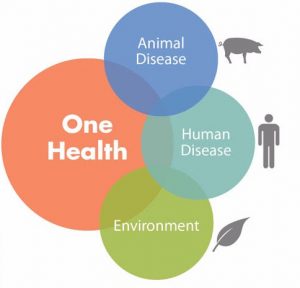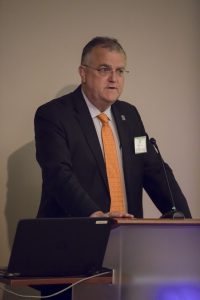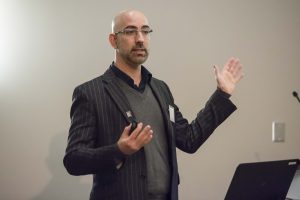One Health: A United Approach to a Healthier World
Allison LaHood
“Do you have what it takes to save humanity? As skilled members of a disease-fighting team, you must keep four deadly diseases at bay while discovering their cures!” I dramatically recited these words from the instruction manual of my new board game, Pandemic, as my friends ripped the plastic off the cards. All of us were freshmen in biomedical engineering, and the prospect of curing imminent diseases invigorated us as we were just starting our academic careers. The board consisted of a world map with lines connecting the major cities on all continents, and each player picked a “role card” that outlined their specific strengths in handling emerging infectious disease. My role as the Operations Expert was to build research stations across the map. Madeline, the Quarantine Specialist, prevented the spread of outbreaks. Our Researcher, Miranda, had the ability to share crucial knowledge to any other player. And finally, Sherry the Medic could treat any disease that had already been cured. We laughed, strategized, and hyperbolized every outbreak that befell our tiny world of Pandemic that day. Three years later, in my last semester as an undergraduate student at Illinois, I sat with a pencil in hand to report on the “Uniting Infection Biology for One Health” symposia. I did not anticipate thinking back to that silly game and how much it paralleled this day. All of us at the symposia were from different backgrounds, age groups, institutions, and even continents. There were veterinarians, medical doctors, environmentalists, and engineers, among biologists, lawyers, parasitologists, and geographers. Yet, we had all managed to gather in one place to discuss the world’s most pressing issues from a unified One Health perspective.

One Health as a concept is focused on the interdisciplinary effort to achieve optimal health for humans, animals, and the environment on a local, national, and global scale. Although the actual term “One Health” was coined quite recently, the linkages between veterinary and human medicine have been observed for centuries. While studying roundworm in the 19th century, a German pathologist named Dr. Virchow coined the term “zoonosis” to categorize infectious disease passed between animals and humans. Later, in 1964, Dr. Calvin Schwabe used the term “One Medicine” to propose a collaboration between human and veterinary doctors so that the burden of illnesses as a whole could be addressed more productively. However, it wasn’t until a symposium in 2004 at Rockefeller University, New York City, that the “One Health, One World” concept was introduced. Since its inception, One Health has become a pillar in academia, providing an avenue for collaborative discussion on health issues amongst scholars of diverse backgrounds and interests. Putting a name to a concept that has been emerging for some years allows One Health to manifest itself in the global and public health sphere. The result is that people from different disciplines intentionally convene to share ideas for a common goal: increased health for the world. Such an event occurred at the University of Illinois this year.
As an homage to its past and a look forward to the future, Illinois hosted the sesquicentennial symposium on April 11, 2018, to highlight areas of research for the public good. Fifty years ago, a parallel symposium was held for the university’s 100th anniversary. The president at the time, David D. Henry, discussed human issues such as “…the problems of our cities, of water and air pollution, of disease and health care, of family sustenance and decent family living conditions, and of equality of individual education and employment as means to human dignity.” Fifty years later, Illinois returned to the concerns President Henry addressed by assembling experts from around the world to discuss the future of research for the public good in six distinct symposia. Topics for these symposia were extremely diverse and ranged from postulating “technocultural futurisms” to examining police brutality and racialized deaths. The six symposia, though distinct, all convened around the collective and individual well-being of people to determine the role of research for the public good in the 21st century.

The morning commenced with a brief welcoming talk by the dean of the College of Veterinary Medicine at Illinois, Dr. Peter Constable. Dean Constable was candid in his opening by imparting the importance of One Health through occurrences in his own life. As a child, Constable recalled the awe he and others of his generation felt after seeing the photo of Earth from the Apollo for the first time. This moment for him brought to light the interconnectedness of the planet as a whole and all its inhabitants. Flashing forward to just days prior, Constable laughed and recollected his flight to Illinois from Australia. The person next to him was coughing, and he couldn’t help but be reminded how easily infectious disease can cross borders.
Dean Constable welcomed Dr. Robert Tauxe, the opening keynote speaker, to the podium. Decorated with a bachelor’s degree in cultural anthropology at Yale, a Master’s of Public Health at Yale, and a Doctorate of Medicine from Vanderbilt University, Tauxe has the perfect background to approach epidemiological issues with a One Health vigor. He began his career at the Centers for Disease Control and Prevention epidemic intelligence service in Atlanta and currently holds the position of Director of the Division of Foodborne, Waterborne, and Environmental Diseases. As he took the podium, he immediately suggested that the young academics in the room pursue careers in epidemics because it is a field that is “ever-renewing, ever-stimulating, and a worthy challenge.” As an opening, he told us why the CDC was staked in Atlanta. During World War II, all of the military training was in the Southeast, and malaria was simultaneously endemic in the same region. Consequently, public health officers were placed at the center for the Malaria Control Program in Atlanta and directly addressed every malaria case whenever the phone rang. After 2.5 years, the phone had stopped ringing. They had successfully eradicated malaria in the United States by using the concept of ring circling. The program decided to expand rather than disband by addressing other health problems such as polio and salmonella and eventually became the CDC. Tauxe says that the concept of ring circling and mapping every incidence of a disease has been used ever since the early days in the CDC, and definitely throughout his own career. When he started at the CDC, he joined an exciting team that worked on E. coli 157. Patients in Oregon had been hospitalized from severe symptoms such as bloody diarrhea and debilitating cramps, but all tested negative for pathogens. Once they investigated where the incidents occurred and what similarities the patients had, they realized that all factors traced back to a specialty hamburger at a fast food restaurant. Next, they started comparing the bacterial compositions of health and diseased feces and found that E. coli was the differentiating factor. Tauxe went on to mention many important foundational disease studies throughout his career, including the discovery of Vibrio vulnificus in live tilapia markets in Israel, Nipah virus encephalitis harbored in bats in Bangladesh, and the dangers of emerging antimicrobial-resistant bacteria. Now, the CDC is focused on whole genome sequencing and establishing routine public health surveillance to better characterizes the rapid changes and mutations bacteria are experiencing, or essentially a modern “ring circle” like the malaria control efforts in the past.

Dr. Tauxe’s career focused extensively on diseases affecting humans, but it was important to have a veterinary perspective on disease transmission. Dr. Stuart WJ Reid opened the next session with a keynote filled with thought experiments and pieces of his own work as Principal of the Royal Veterinary College at the University of London. Reid asked the audience, “If the waters were rising on the planet and there are a limited number of lifeboats, which professions would the society choose to retain?” He said when asked this question before, the first professions to go were the lawyers and real estate agents, but the second, third, and fourth were the veterinarians. He wondered how veterinarians have become so misunderstood by the public even though they do so much for the public good. He went on to discuss the real meaning of One Health, and how that approach depends not only on expertise in multiple health sectors, but on shared understanding across those sectors of the technical, social, and institutional concerns at hand. For example, the rabies vaccine is effective, but there is no real global institutional commitment to eradicating the disease. Reid published a paper that received a great deal of harsh criticism from the research community because his findings opposed a previously understood transmission model. Despite the backlash, Reid went on using statistical methods to further prove his findings. He concluded that we, as a research community, don’t have all of the answers because we need more advanced tools to store the vast amounts of data we can collect. When it comes to antimicrobial resistant bacteria, what we have is data on the “easily identifiable” regions of a puzzle. We need to consider space, time, and the determinants of disease rather than just the bacteria itself. Like Dr. Tauxe, Dr. Reid believes that investing in surveillance and whole genome sequencing is the next big step to understanding disease transmission.

After a series of lightning talks by Illinois faculty and a recess for lunch, it was time for the last keynote speaker. Dr. Tom Gillespie, an Associate Professor in the Department of Environmental Sciences at Emory University, gave us an ecological perspective on One Health. Gillespie’s research was focused on sociality and disease in wild primate populations that interface with rural human populations in a variety of locations around the globe. In Kibale National Park, Uganda, Gillespie compared the red-tailed guenon populations in the selectively logged Northern sector of the park and the untouched Southern sector. He found that guenons in the north had far more parasites than guenons in the south and that clearly, the ecological structure altered the parasitic infections in this primate. Gillespie was then curious whether microbiomes within the logged areas of the park reflected their interaction with humans and livestock. By examining the E. coli variations within species at different sites of the national park, he found that the humans and livestock near the logged forests had E. coli isolates similar to guenons. This led him to continue investigating the shared transmission of animals and humans in changing environments all around the world. As the last keynote, he rounded out the day by bringing to light the immense effects environmental health poses on animal and human populations of the Earth.

Until the end of the symposia, it never crossed my mind that my beloved board game, Pandemic, was flawed. Though seemingly diverse, all seven roles available for the players only had strengths in mitigating human disease. The game completely neglected the essential roles of veterinarians and environmental scientists in tackling disease outbreaks, and as a rebuttal, I would like to form a One Health Pandemic Redesign Committee. The head of my committee would undoubtedly be Dr. Robert Tauxe of the CDC because of his well-rounded expertise in the humanities, foodborne, waterborne, and environmental illnesses. Of course, we need an eminent veterinarian on our team, so I’ll enlist Dr. Stuart WJ Reid of Royal Veterinary College, London for the challenge. Lastly, to give proper weight to the effects of environmental health in epidemiology, Dr. Tom Gillespie at Emory University will provide a much-needed perspective to our task. Together, this committee would shed light on the disregarded components of health, much like the “Uniting Infection Biology for One Health” event. As long as we keep bringing people from different disciplines together, One Health will continue to grow as a movement to solve the world’s most pressing health issues. On that day, three years ago, right before drawing my role card, I recited the concluding lines of the Pandemic instruction pamphlet. “…you and your teammates will travel across the globe, treating infections while finding resources for cures. You must work together, using your individual strengths to succeed. The fate of humanity is in your hands!”



